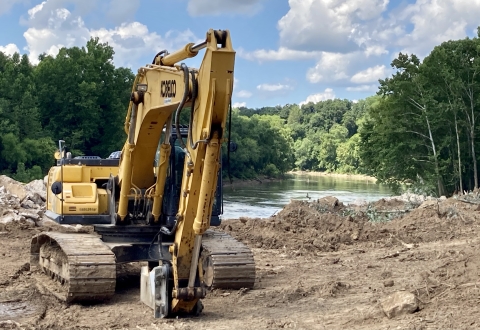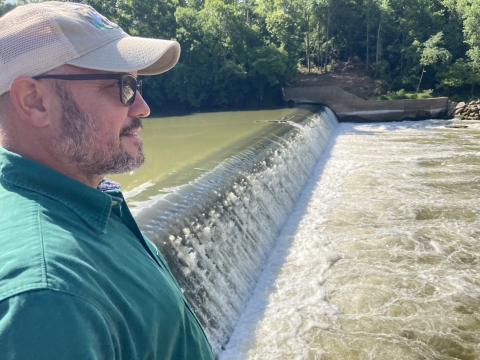Woodbury, Kentucky – Federal, state and local environmentalists are preparing to do what more than a century of rushing water has not achieved: Demolish a lock and dam. It will change a stretch of the Green River forever.
Officials from practically every level of government gathered Monday, June 28, to take a last look at lock and dam No. 5, a half-hour drive from Bowling Green. The dam, 100 yards across, and the lock, which is 120 yards long, are the latest Green River structures whose days are numbered. They’ve been in place since 1900; by Sept. 30, they should be gone.
The U.S. Fish and Wildlife Service (Service) is leading the $4.6 million project. Other agencies – the U.S. Army Corps of Engineers, Kentucky Department of Fish and Wildlife, Kentucky Waterways Alliance, The Nature Conservancy, among others – are working with the Service. The project also has the blessings of Kentucky lawmakers U.S. Sens. Mitch McConnell and Rand Paul, as well as Rep. Brett Guthrie, whose district includes the lock and dam.
The Service has long wanted to dismantle the structures, originally built to help barges travel toward the Ohio River. They operated until 1951. Since then the lock and dam have attracted anglers, people wanting to play on the Green’s banks and the occasional graffiti artist.
Removing the lock and dam will help restore a “piece of paradise,” said Leopoldo Miranda-Castro, Regional Director of the Service’s Southeast region, which includes Kentucky.
“There’s something really special about this watershed,” Miranda said during a brief gathering Monday morning to officially kick off the removal. More than two dozen people nodded in agreement.
He looked over his right shoulder toward the river. A couple of hundred yards away, water poured over the dam’s concrete wall, a sound somewhere between a whisper and roar. The water fell about a dozen feet down the dam wall, striking the river’s lower level and boiling to the surface in white billows. Just downstream, the river grew quiet again and resumed its peaceful path toward Ohio.
Miranda smiled. “I’m really bummed I didn’t bring my fishing rod today,” he said.
The Green River abounds with fish, from darters that fit in your hand to catfish that could swallow it. The river is considered one of the most biodiverse in the world. Removing the lock and dam, say biologists, will create an even better habitat for a wealth of creatures – fish, mussels, crayfish.
The latest job shows what happens when organizations cooperate, said Linda Murphy, a district engineer for the corps. The agency owns the lock and dam.
“This is a great example of … everybody in the community coming together to make sure this happens,” she said. “We’re really proud to be a partner in this.”
This is not the first time the Service and corps have collaborated to remove manmade structures from the Green River. In 2017, they took out lock and dam No. 6, about 30 miles upriver from the current job site.
Work taking place on the Green underscores what is happening on other rivers, too. In the last century, almost 1,800 dams have been removed from waterways across the country, according to statistics from American Rivers. A nonprofit, the organization is an advocate for healthy river systems.
The push to remove dams also appears to be gaining momentum. Last year, 69 dams were dismantled, said Lisa Hollingsworth-Segedy, director of river restoration in the nonprofit’s western Pennsylvania field office. A native of Kentucky, she’s kept close watch on what happens on the Green River.
“I’m super-excited” about the project, said Hollingsworth-Segedy. “It has way aged-out.”
Yet removing dams involves more than heavy machinery and cash, said David Phemister, executive director of The Nature Conservancy’s Kentucky office. It requires the human touch, he said. “A project like this does not happen unless you have a ton of people working together, pulling in the same direction,” he said.
The work now begins in earnest.
The ceremony finished, conservationists, biologists, engineers and others shook hands goodbye. But a few people remained at the river’s edge. They wore hardhats and T-shirts that proclaimed Aquatic Habitat Restoration Team.
They walked toward bright-yellow machines – excavators, some outfitted with bullet-shaped tips designed to shatter concrete, others with buckets to pick up what the others destroyed. Moments later, they clattered to life. They moved slowly toward old concrete that had long outlived its usefulness.
The lock and dam soon will be gone.






